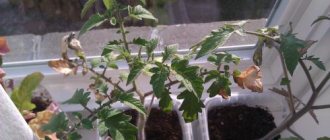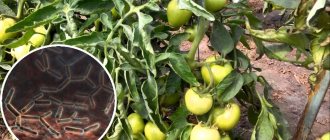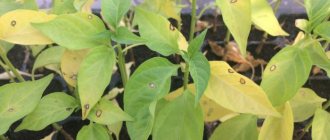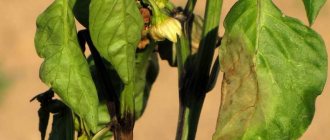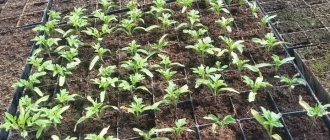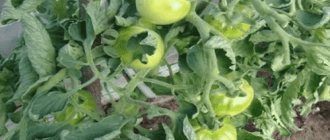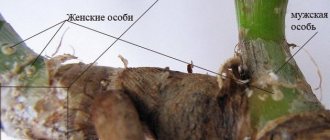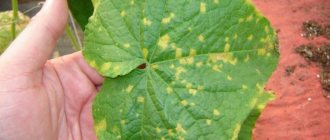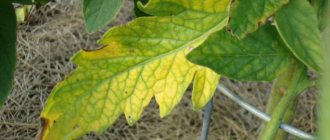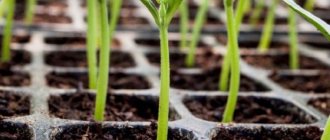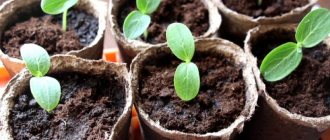Home / Pests and diseases
Back
Published: 06/10/2019
0
3/5 — (1 vote)
Yellowing of leaves on tomato bushes is a frequent and frightening phenomenon for gardeners. Everyone immediately begins to worry - is it really late blight, is it really possible that we won’t see the harvest anymore? But it's not all that scary. In most cases, tomato leaves turn yellow for other reasons - harmless and not so. Our article will help you understand this.
- 1 Natural causes
- 2 Diseases and pests
- 3 Wet mode
- 4 Lighting
- 5 Problems with the root system
- 6 Errors in nutrition
Natural causes
There are a number of natural factors why tomato leaves turn yellow and dry:
- The end of its lifespan - the leaf lives on average 3 months and by mid-summer the very first ones have already served their purpose and begin to die off. They turn yellow and dry out even on healthy bushes.
- The leaves of tomato seedlings may turn yellow due to the tightness of the root system. After transplantation, the plates can restore normal color.
- The leaves of seedlings also turn yellow due to lack of light - most varieties of tomatoes require additional lighting after emergence.
- Stress after transplanting into a greenhouse or open ground. The plant finds itself in completely different conditions and in order to quickly adapt to them, the bush gets rid of excess tops.
- In addition, during this period there is a temporary disruption in the supply of water and nutrients. The plant in such situations (as in drought) tries to maintain viability and rejects old leaves in favor of young ones. Disturbed root nutrition after transplanting bushes with bare roots is restored in 7-10 days.
- The natural reasons why only the tips of the leaves of tomato bushes turn yellow include the result of hypothermia of the roots after transplanting into a greenhouse or garden beds. This can only be combated by covering the plantings with spunbond or installing temporary greenhouses, creating comfortable conditions.
In all these cases, you should not panic, but just wait a few days. The situation will correct itself.
The lower leaves of tomatoes turn yellow
For adult plants, yellowness from below is a normal biological course of events, because they develop and age. Tomatoes shed “ballast” to concentrate resources on the development of young shoots and fruit formation. If there are no other symptoms and you are in good condition, you do not need to do anything.
Sometimes the lower leaves wither immediately after transplantation - this is a natural reaction of sprouts to stress. You need to keep the top healthy, and the seedlings can handle the rest on their own. When the leaves below finally die off, just remove them as soon as possible so as not to create favorable conditions for diseases.
Photo: prorastet.ru
Diseases and pests
Many people believe that this is the main reason for the yellowing of leaves on bushes, but they are wrong. This factor accounts for no more than 20% of cases of yellowness of the leaf apparatus, and the situation is accompanied by other manifestations.
Diseases that cause yellowing of foliage in the first stages, and what other symptoms:
- Late blight - yellow spots appear on the leaves, then they turn brown and dry out.
- Tomato mosaic begins with the appearance of yellow spots, which gradually merge and the leaves dry out.
- Another disease of tomatoes in which the lower leaves turn yellow is fusarium. First, part of the leaf turns pale, then turns yellow, the veins become discolored. Subsequently, the foliage curls and dies. A white coating is visible on the lower part.
- Some diseases and pests cause problems with the root system. This could be root rot - the bushes cannot be saved, the plant must be removed from the garden or in a greenhouse and the soil must be disinfected. Mole crickets and cockchafer larvae also destroy the roots - they must be dealt with by any means.
If the cause of yellowing of tomato leaves is disease, then you can try to stop their development with the help of systemic fungicides - Revus, Thanos, Quadris, Ordan, Ridomil Gold, Consento, Aliette.
Another reason why tomato bushes often turn yellow in open ground and in polycarbonate or film greenhouses is pests. They suck the juices from the leaves. Most often these are aphids, thrips, whiteflies, and Colorado potato beetle larvae. You can get rid of this scourge with the help of insecticides - Confidor, Iskra M, Decis, Tomato Rescuer, Enzhio, Imidor.
Prevention measures
- Before sowing seeds for seedlings, it is imperative to disinfect them to avoid infection with fungi.
- When growing tomatoes, it is necessary to take into account the characteristics of the variety and carry out the correct agricultural techniques.
- Leaves that have turned yellow, curled, or have spots on them must be torn off. During the fruiting period, the lower leaves of tomatoes die off due to natural aging. This is a natural process; such leaves should be removed first.
- Do not remove many leaves at one time. You can remove 3-4 diseased leaves at a time without damaging the plant.
- Leaves can be torn off by hand; scissors can be used for this purpose. The main thing is to tear them off carefully, avoiding damage to the stem.
If you properly care for tomatoes and carry out all agrotechnical measures during the growing season in a timely manner, then there will be no problems with growing tomatoes.
Wet mode
Providing tomatoes with sufficient moisture is one of the main tasks of a gardener. This is not easy to do, especially if the site is outside the city or in the middle of a field. During prolonged drought, in order to preserve the harvest, the bushes reduce the area of moisture evaporation - the leaves dry out below, and at the top they turn yellow and curl. What to do? We need to think about how to organize regular watering. A great idea is a gravity drip system. You can bury a plastic bottle of water near each bush.
Plants suffer not only from a lack of moisture, but also from an excess of moisture. Due to prolonged rainfall, which washes nutrients from the soil, chlorosis of tomato leaves begins. Excess moisture can be removed only by digging drainage grooves that drain water outside the beds. The addition of urea or nitroammophoska at the rate of 2 g per 1 sq.m. will help restore nutritional deficiency.
Another danger why tomatoes turn yellow after planting in the ground is a high groundwater level. If such a factor is present on the site, you need to take care in advance about the comfort of the tomato roots. This will help with the arrangement of drainage, ridge ridges or the construction of high beds.
Tomato leaves turn yellow after planting
Planting is always stressful for seedlings, and it affects their well-being and appearance. Adaptation is a normal feature of the life cycle, not limited to plants. But if the situation does not stabilize on its own in the near future, the reasons may lie deeper.
— A fungus or larvae of pests could remain in the soil, which now eat the young seedlings;
— When replanting, it is especially easy to damage the delicate root system. If the damage is minor, the plants will return to normal on their own;
— Sprouts react most quickly to improper watering, so monitor the moisture level of the substrate;
- If it turns out that it is still too cold outside, the tender young foliage of the seedlings will turn yellow. Wait for stable warming, because the rush to replant can cause damage to the crop. It could even be June in the northern regions.
Photo: poradum.com.ua
Lighting
Another factor from the list of reasons is a lack or excess of light. Yellowing of the leaves of tomato seedlings occurs in the first month, when there is not enough natural light, and the seedlings become elongated, thinner, and pale. Additional lighting helps correct the situation, but when planting, plants must be buried.
Tomatoes are light-loving plants; planting in shaded areas leads to the tops of the tomatoes turning yellow and a sharp decrease in yield. What to do - practically nothing. Is it possible to try transplanting a bush with a large lump of earth into a lighted place.
Density of plantings also leads to insufficient insolation. Per square meter it is optimal to plant 4 bushes of standard tomatoes and 4-5 bushes formed into one stem.
Too much sun is also dangerous for tomatoes. Tomatoes in a greenhouse especially often suffer - their leaves turn yellow from too bright rays, especially when the bushes are not yet strong enough. After planting, it is advisable to shade the plants for at least 2 weeks. Spraying the bush in the morning if hot weather is expected can also help. You can throw on white lutrasil or spunbond - this will reduce the temperature in the greenhouse.
Poor quality soil
If tomato seedlings begin to turn yellow at the cotyledon stage, you need to pay attention to the quality of the soil. The soil must be thoroughly disinfected and have the correct composition.
Heavy peat soil is characterized by high adhesiveness, so it is not suitable for growing tomatoes. Dense areas that do not contain air provoke oxygen starvation of the root system. This interferes with the normal nutrition of the seedlings. As a result, the foliage begins to turn yellow and fall off.
Too acidic soil forms nitrogen, potassium, and phosphorus salts that are not absorbed by plants. An excess of inorganic additives and hard water during irrigation are the reasons for its salinity.
The mixture with the following composition is most suitable for propagating tomato seedlings:
- turf – 1 part;
- river sand – 1 part;
- peat - 1 part;
- perlite - 1 part;
- coconut substrate - 1 part;
- ash – 0.5 parts.
To strengthen the protective forces, it is recommended to water the plantings with melt or rain water.
Problems with the root system
Often tomatoes turn yellow, the leaves dry out due to poorly developed or damaged roots, which are unable to provide adequate nutrition to the above-ground part, especially during the period of filling and ripening of the crop. The reasons for this can be very different:
- inaccurate picking, transplanting and disembarking;
- pests;
- excess nitrogen fertilizers (fatting seedlings);
- damage to roots during loosening.
There is only one way to help tomatoes with root yellowing of leaves - you need to urgently treat the plant with a growth and root formation stimulator. These are Epin, Larixin, Heteroauxin, Novosil, Kornevin. The solution should be watered onto the soil under the bushes.
And to help the plant recover faster, you should apply foliar feeding with nutrients. Such folk remedies as yeast solution and infusion of nettle, other weeds, as well as ECO fertilizers and stimulants help very well.
If the cause is root rot, in the initial stages of fungal infection the soil must be treated with Previkur, Tiovit, Cumulus or colloidal sulfur. In case of generalized infection of the entire bed, the means to treat the bushes and soil is
0.25% suspension of Metaxyl or Ridomil Gold MC. If it doesn’t help, burn the plants, sterilize the soil and sow mustard or radish on the green manure.
Traditional methods of combating yellowing of tomato leaves
There are no special folk methods for yellowing leaves. But there are folk methods of combating the causes of yellowing.
- To prevent infection with fungal diseases, tomatoes are treated with a solution of iodine and whey.
- To protect against insects, seedlings are dusted with ash and protective plants are planted nearby: calendula, marigolds.
- The beds are mulched to normalize soil moisture.
- They also fertilize with organic fertilizers.
- All this helps prevent changes in leaf color and the further development of various diseases.
Errors in nutrition
This is one of the most common reasons why foliage turns yellow, and not only a lack of basic micronutrients is harmful to the plant, but also their excess. Since problems with nutrition have other signs, including where the yellowing begins - on the upper leaves or below, is it massive, or only on part of the plant.
Nitrogen
Nitrogen deficiency manifests itself as follows:
- the leaves become light yellow or discolored;
- young ones grow small and irregular in shape;
- The fruits do not set well and are also small.
If tomatoes turn yellow from a lack of nitrogen, you can fertilize them with a solution of urea, mullein, or bird droppings. Foliar feeding gives good and quick results.
An excess of nitrogen nutrition also leads to yellowing of the leaves. The plant begins to fatten, driving away the green mass to the detriment of flowering and fruiting. The root system cannot cope with the growing needs of the aboveground part, which leads to the death of the tops. It is difficult to get rid of excess nitrogen - you will have to literally wash it out of the soil by repeated watering.
Phosphorus
The deficiency of this essential nutrient can be determined by the appearance of the tomato bush - it becomes frail, the leaves are not limited to yellowing, but become purple at the bottom, the edges curl, the lower rows simply die off. For feeding, nitroammophoska, superphosphate, and ash are added.
With an excess of phosphorus, the leaves turn completely yellow, bright necrotic spots appear on them, and they gradually die.
Potassium
It is also one of the main nutrients; if it is deficient, the lower leaves of tomatoes first turn yellow and dry out, and the process begins from the edges. The new leaves are small and very thick, the stems become woody. Treating the leaves and roots with a solution of potassium sulfate will help correct the situation. For prevention, ash must be added to the holes.
Excess potassium is characterized by elongation of internodes, leaves are pale and mosaic.
Zinc
A lack of zinc causes yellowing of all leaves with the appearance of gray and brown spots, which quickly grow and the leaf dies. What to feed? The easiest way is to do a foliar dousing with a solution of zinc sulfate.
An excess of Zn leads to chlorosis, the veins become transparent, and the leaves fall off. Without fading.
Magnesium
Magnesium deficiency causes the plates to curl, between the veins they turn yellow and become covered with gray-brown spots. It is impossible to save such leaves, and the bush must be watered with a solution of magnesium nitrate (5 g/10 l).
Too much of this element causes the leaves to wrinkle and curl, turning them dark green.
Calcium
With a lack of calcium, the upper part of the bush turns yellow, and the lower tier becomes bright green. The flowers fall. To save the plant, you need to dilute calcium chloride and apply foliar feeding.
If there is an excess, interveinal chlorosis of tissues with pale, necrotic spots occurs. The bush grows quickly upward, but the side shoots die off.
Bor
With its deficiency, only the crown turns yellow, and the whole plant curls, sheds flowers and ovaries. Spraying with a 1% solution of pharmaceutical boric acid will help.
Excess boron causes yellowing, chlorosis, then bending of petioles, the appearance of spots and death of leaves.
What fertilizers can be used against yellowing?
If it is impossible to accurately determine the cause of yellowing, then use complex preparations. For example, Azofoska or Nitrophoska. You can use ready-made liquid and granular preparations: Agricola, Gmi-Omi, Gera, etc.
If you can determine the deficiency of some element based on a specific sign, then feed it with the appropriate fertilizer. For example, urea if there is a lack of nitrogen.
Treatment of phosphorus starvation
If the seedlings turn purple, first of all you need to adjust the temperature, and then think about what to feed. Excess fertilizer is no less dangerous than too little.
Temperature increase
If the seedlings turn purple and the leaves are raised up, the reason is definitely the low temperature. When it is adjusted, the color of the vegetative organs will return to normal.
Sometimes, in order for leaves that are purple underneath to regain their natural color, you only need to raise the temperature a few degrees. For this it is enough:
- move the box with tomatoes 5-10 cm away from the window, or at least so that the leaves do not touch the glass;
- if the seedlings are illuminated by a table lamp, lower it a little;
- place foil between the glass and the seedling containers;
- regularly rotate the box relative to the window;
- in the greenhouse you can place purple tomatoes higher up - it’s always a little warmer there.
Feeding
Only if the increase in temperature does not help, or the owners know that the tomatoes that have turned purple definitely do not have enough phosphorus, can they start fertilizing. In this particular case, all drugs containing the element are divided into two groups:
- phosphorus acts immediately;
- the macronutrient must be made easily accessible to tomatoes.
Among the drugs ready for immediate use:
- potassium sulfate or potassium sulfate for fertilizing the soil;
- magnesium sulfate for spraying;
- Potassium monophosphate works well under the root and on the leaf.
But these drugs work at temperatures above 15° C. What to do if the tomatoes are purple, they clearly lack phosphorus, and there is no way to increase the temperature? In this case, it is good to have the new Israeli drug Picoside on hand. It saturates plants with P even at low temperatures.
The phosphorus contained in fertilizers such as superphosphate, dolomite flour, azophosphate, etc. can be made readily available to plants in different ways. The simplest is to pour a tablespoon of the drug into a glass of boiling water, cover with a lid, and let it brew for at least 8 hours. Dilute with water to 2 liters and water the seedlings.
